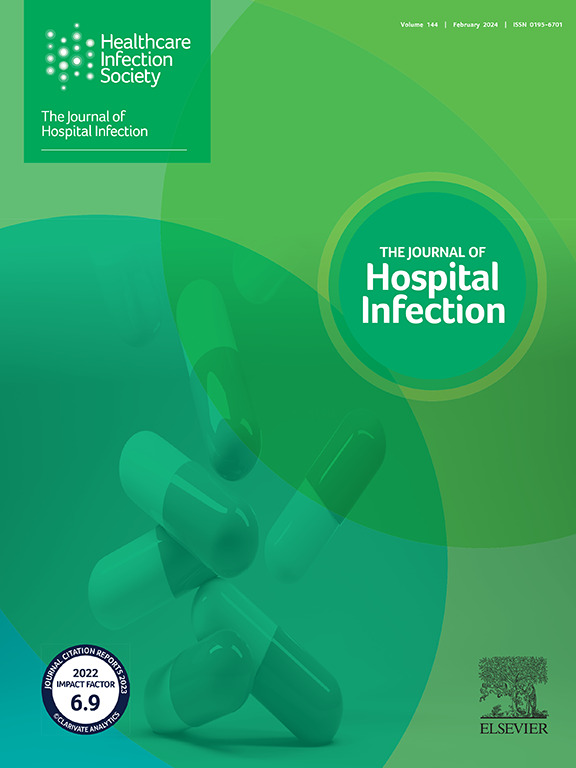真空辅助沸腾清洗消毒器对刚性内镜器械清洗效果的比较:清洗周期参数的影响。
IF 3.1
3区 医学
Q1 INFECTIOUS DISEASES
引用次数: 0
摘要
背景:真空辅助沸腾清洗消毒器被广泛用于清洗刚性内镜器械,但标准的清洗周期耗时,影响器械的周转率。目的:比较不同清洗周期参数对刚性内镜器械的清洗效果,确定平衡效果和效率的参数设置。方法:将600台腹腔镜胆囊切除术中使用过的刚性内镜器械随机分为4组,分别为1个对照组(标准参数)和3个酶洗时间、温度、洗涤剂浓度不同的试验组。通过5倍放大镜和内窥镜目视检查、三磷酸腺苷(ATP)生物发光试验和残留蛋白检测来评估清洁质量。结果:使用5倍放大镜和内窥镜目视检查四组间清洁合格率无显著差异(P < 0.05)。三磷酸腺苷生物发光检测和残馀蛋白检测差异有统计学意义(P < 0.05)。两两比较,A组的合格率高于C组和D组(P < 0.0167)。ATP生物发光实验中,各组相对光单位(RLU)值差异有统计学意义(P < 0.05): A组RLU值低于B、C组,D组RLU值低于C组(P < 0.001)。结论:提高真空辅助沸腾洗消毒器的酶洗温度,弥补冲洗和漂洗步骤,缩短了清洗时间,提高了硬质内镜器械的再处理效率,同时保持了较高的清洗质量。本文章由计算机程序翻译,如有差异,请以英文原文为准。
Comparison of cleaning effects of vacuum-assisted boiling washer-disinfectors on rigid endoscopic instruments: impact of cleaning cycle parameters
Background
Vacuum-assisted boiling washer-disinfectors are widely favoured for cleaning rigid endoscopic instruments, but the standard cleaning cycle is time-consuming, which affects the turnover of instruments.
Aim
To compare the cleaning effects of different cleaning cycle parameters on rigid endoscopic instruments and determine parameter settings that balanced effectiveness and efficiency.
Methods
Six-hundred rigid endoscopic instruments that had been used in laparoscopic cholecystectomies were randomly divided into four groups, including one control group (standard parameters) and three experimental groups which differed in enzymatic washing time, temperature, or detergent concentration. The cleaning quality was assessed via visual inspection with a 5× magnifier and borescope, adenosine triphosphate (ATP) bioluminescence assay, and residual protein detection.
Findings
No significant difference was found in the cleaning qualification rate among the four groups using a visual inspection with either the 5× magnifier or the borescope (all P>0.05). However, significant differences were observed in the ATP bioluminescence assay and residual protein detection (all P<0.05). Pairwise comparisons revealed Group A had higher qualification rates than Groups C or D (P<0.0167). Significant differences in relative light unit (RLU) values were observed between groups in the ATP bioluminescence assay (P<0.05): Group A showed lower RLU values than Groups B and C, and Group D showed lower RLU values than Group C (all P<0.001).
Conclusions
Increasing the enzymatic washing temperature of the vacuum-assisted boiling washer-disinfector to compensate for the flushing and rinsing steps shortened the cleaning time and improved the reprocessing efficiency of rigid endoscopic instruments while maintaining high cleaning quality.
求助全文
通过发布文献求助,成功后即可免费获取论文全文。
去求助
来源期刊

Journal of Hospital Infection
医学-传染病学
CiteScore
12.70
自引率
5.80%
发文量
271
审稿时长
19 days
期刊介绍:
The Journal of Hospital Infection is the editorially independent scientific publication of the Healthcare Infection Society. The aim of the Journal is to publish high quality research and information relating to infection prevention and control that is relevant to an international audience.
The Journal welcomes submissions that relate to all aspects of infection prevention and control in healthcare settings. This includes submissions that:
provide new insight into the epidemiology, surveillance, or prevention and control of healthcare-associated infections and antimicrobial resistance in healthcare settings;
provide new insight into cleaning, disinfection and decontamination;
provide new insight into the design of healthcare premises;
describe novel aspects of outbreaks of infection;
throw light on techniques for effective antimicrobial stewardship;
describe novel techniques (laboratory-based or point of care) for the detection of infection or antimicrobial resistance in the healthcare setting, particularly if these can be used to facilitate infection prevention and control;
improve understanding of the motivations of safe healthcare behaviour, or describe techniques for achieving behavioural and cultural change;
improve understanding of the use of IT systems in infection surveillance and prevention and control.
 求助内容:
求助内容: 应助结果提醒方式:
应助结果提醒方式:


